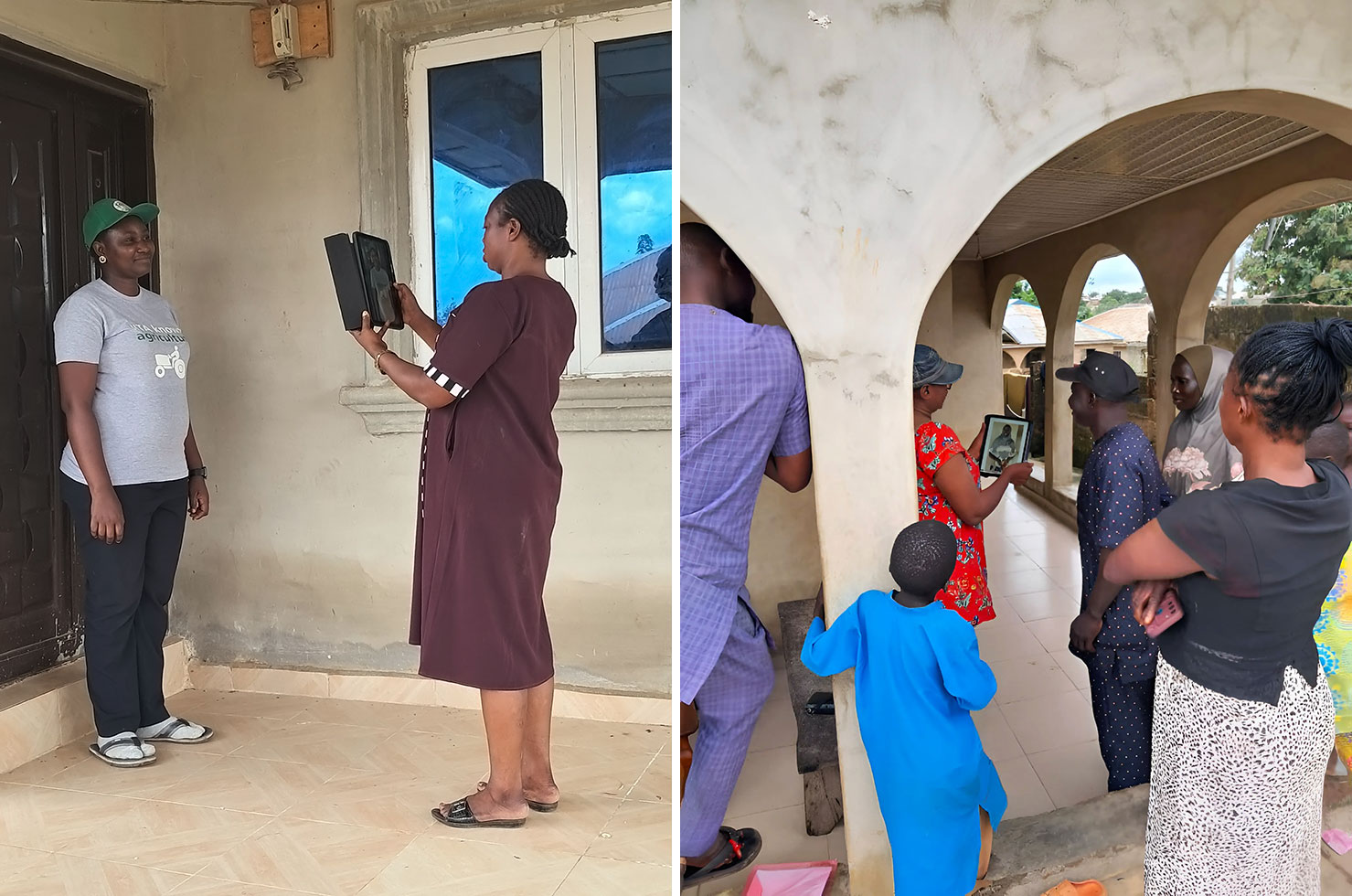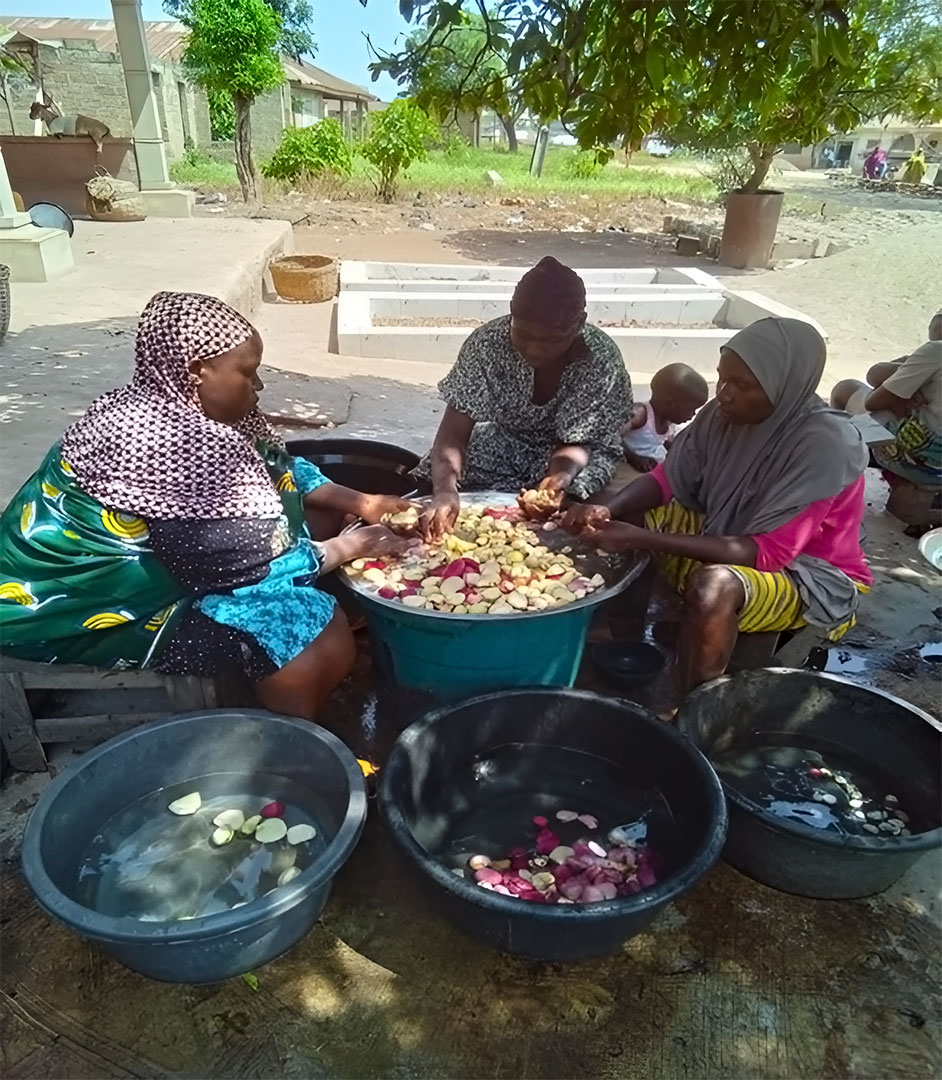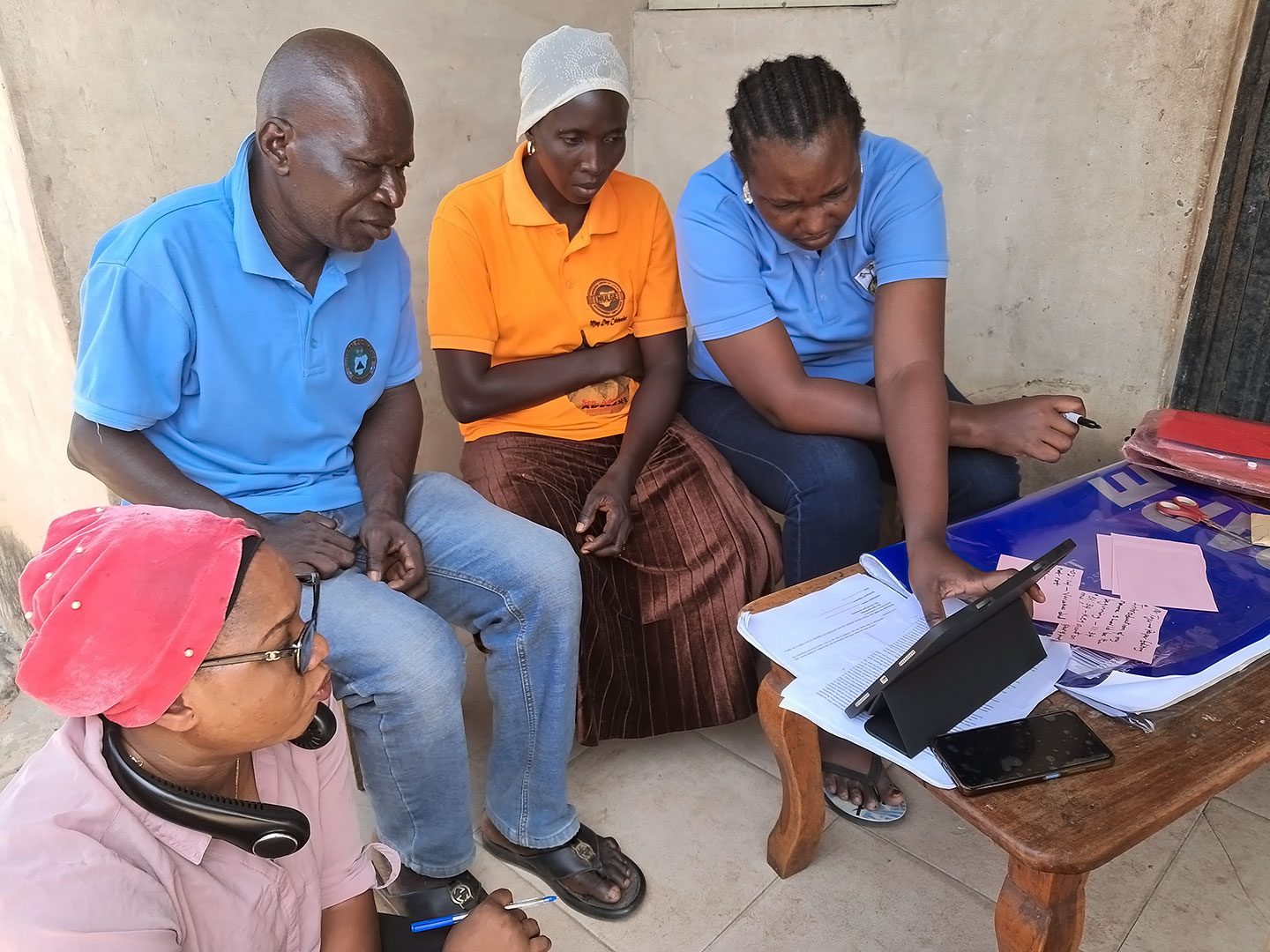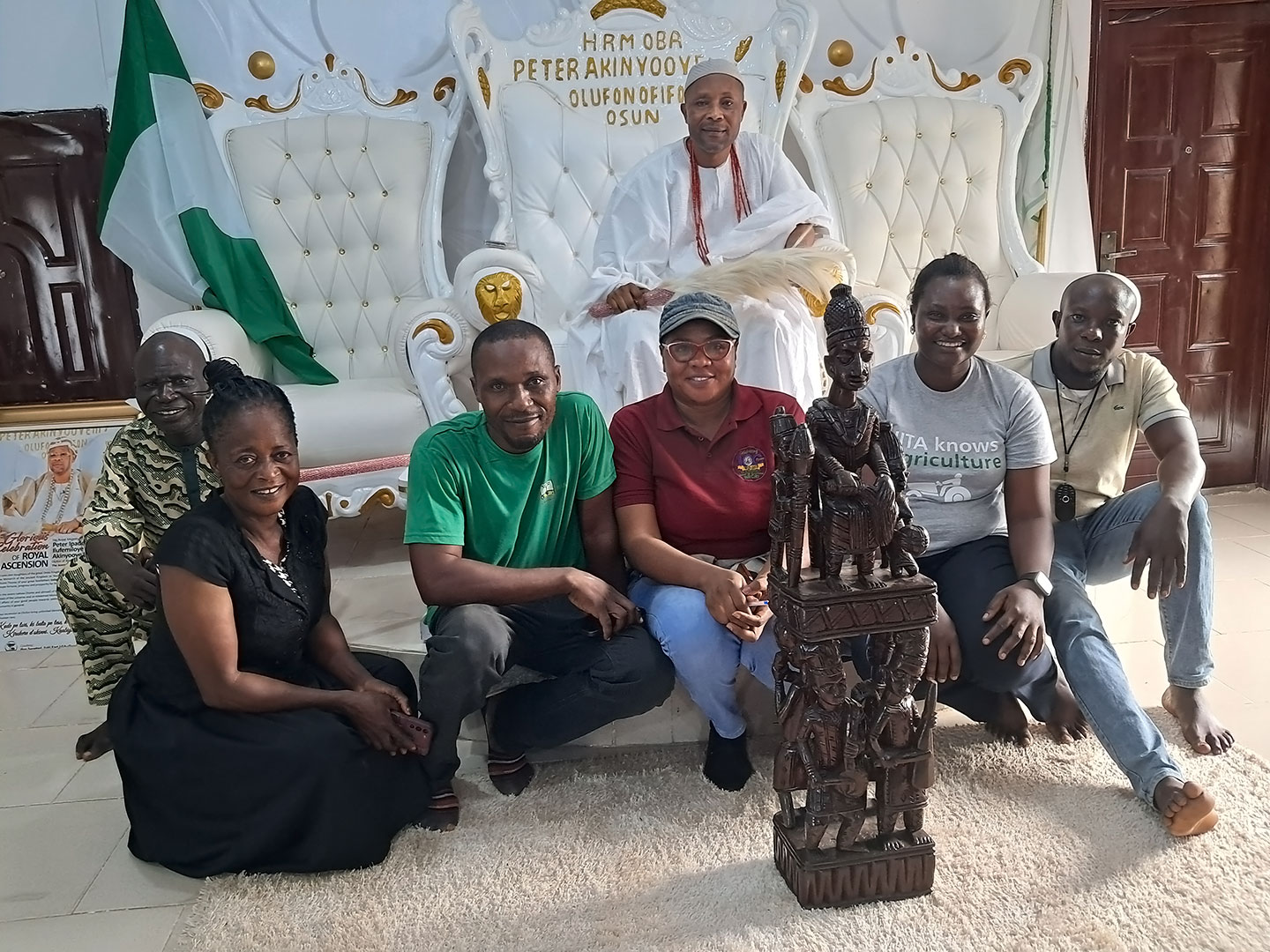Participatory research is not new, but is becoming more inclusive and collaborative, with the introduction of participatory video techniques, a method that has shown to elevate the voices of farmers, enabling two-way communication between researchers, farmers, and other rural community members.
The IITA Roots, Tubers, and Banana gender team was trained in this method in Rwanda through the 1000 Farms Project and recently applied it within tricot trials. Tricot is a citizen science, on-farm approach in which a relatively large number of farmers evaluate, compare, rank, and report on different crop varieties in their own fields. By integrating this video method into tricot, researchers are reshaping how they engage with farmers, fostering horizontal dialogue to gather feedback and co-design innovations. The use of video further enhances tricot, positioning farmers and rural communities as research partners and co-creators rather than mere respondents.
The study took place in three rural communities in Osun State, Nigeria. Interactions unfolded over multiple visits after working with them in tricot trails during the 2023-2024 cassava growing season. Researchers introduced innovative video techniques such as “In Front and Behind the Camera,” “Film Just Like That,” “Searching for Beauty,” and “Show and Tell.” Through these methods, farmers along with their family members, or neighbors, interviewed and filmed the IITA research team, while also documenting what mattered most to them with regards to their participation in the tricot trials, their farming practices, and livelihoods. These techniques transformed traditional data collection into a dynamic and interactive process of self-expression, enabling farmers to explore and share tacit insights and perspectives. By becoming storytellers, the farmers used visual mediums to highlight their experiences, aspirations, and motivations, offering a richer understanding of their lives and feedback.

Processor interviewing and filming IITA research team member (left) and members of a farmer’s household reviewing a video (right)
Reflections and Insights from Participatory Video Techniques and Practice
For some farmers, holding a camera and seeing themselves on screen was an entirely new experience. Mr Tajudeen Odeniyi reflected:
“We usually see only the educated ones on video and television. I feel very happy to watch a video of myself as a farmer sharing my experience. This video shows my children that I am keeping up with the time, engaged in a noble profession and becoming a modern farmer”.
Such moments of pride and recognition are more than anecdotal; they signify a shift in how farmers view their own contributions to agricultural research and their community.
The participatory video techniques employed in the tricot approach exemplified the power of visual storytelling as a tool for empowerment and education. The sessions brought together farmers, their families, and researchers in a unique collaborative effort. During the “Searching for beauty” exercise, a lead farmer’s spouse Mrs Fatimah Odeniyi filmed her kola nut processing activities, explaining the significance of sorting different colors of kola nut and their market values. Her insights added a layer of depth to the study, highlighting the often-overlooked contributions of women in multiple agricultural value chain activities. The process empowered women to step forward as storytellers and decision-makers within their communities.

Women in Osun State sorting Kolanuts by diverse customers preferred colour to be sold on market day
In the “Show and Tell” exercise, participants showcased specific aspects of their farming practices, such as cassava processing, maize fields or house painting skills. These personal demonstrations were deeply enriching, as they allowed farmers to articulate their expertise while engaging their peers in mutual learning. One farmer’s spouse proudly shared how her knowledge of gari processing improved her business and strengthened her family’s financial resilience. The interactive discussions and video practices turned every session into a vibrant exchange of ideas, fostering a sense of community and shared purpose.
Farmers co-created storyboards to document their tricot experiences by editing video materials, selecting key moments for inclusion in a farmer-directed documentary. This final video will be published after participant review and consent. The storyboarding process was highly collaborative, allowing farmers to visualize their journey before, during, and after transitioning from volunteers to lead farmers overseeing trial management. Their responsibilities included collecting and uploading data on variety evaluation. One storyboard highlighted the tangible benefits of newly bred cassava varieties and the adoption of Good Agricultural Practices (GAPs). Lead farmer Mr Sunday Alade shared:
“Before tricot, we planted cassava in any way we liked, mixing varieties and ignoring spacing. Now, we understand the importance of proper planting methods, and our yields have improved significantly.”
The storyboard exercises encouraged participants to recount their experiences creatively. Farmers combined visuals, narration, and pictures to construct compelling narratives. This co-creation process fostered a deeper connection and trust between farmers and researchers while providing a platform for collective problem-solving and co-design of data rather than a one-way extraction of data by researchers. A farmer noted:
“With videos and pictures, we can show what we cannot express in fluent English”.
The integration of phone-based tricot data collection with participatory video techniques not only modernised farming practices but also inspired younger family members to see agriculture as an innovative and viable profession. Parents proudly shared how their children began viewing farming as a respected and forward-thinking career, helping to break generational stereotypes about agricultural work.
The participatory video process served as a mirror, allowing participants to reflect on their experiences and gain insights into their practices. These reviews sparked lively discussions and generated feedback for improving the tricot approach. Farmers were no longer just participants; they became co-researchers and co-designers, actively shaping agricultural research outcomes and progression.

Reflection session and paper editing with a tricot lead farmer Mr Tajudeen Odeniyi and his wife Mrs Fatimah Odeniyi to make the storyboard of a video
Motivations that drive voluntary participation and partnership
Understanding what motivates farmers to voluntarily participate in initiatives like tricot is key to the success of participatory research. For many, the chance to access and test new cassava varieties while gaining valuable knowledge was a major incentive.
Farmers valued the interpersonal relationships they built with researchers, viewing them as partners. Mr Alani Oguntona eloquently summarized his motivations:
“I usually volunteer to ensure that people in my community are part of the first or second set of beneficiaries from any new initiative. I learn new things in the process and meet more people. Volunteering gives exposure, knowledge, and a richer social life.”
“The monitoring and periodic visitation by your team is impressive. Human relation, empathy, and understanding is good. You stayed and planted the trials with us and now we are still harvesting together and doing all the processing together…… When we face any challenge we can easily call … or send messages on Whatsapp and your advice works well…..”
For others, the sense of prestige and recognition associated with collaborating with an international research institution like IITA was a powerful incentive.
Changes brought about among the researchers
The activities also clearly initiated a change in mentality among the research team. They realized that it was not so much about building technical skills but about trust building and commitment to inclusivity. Durodola Owoade, senior research associate at the cassava breeding unit explained:
“One of the most powerful moments for me was handing the camera over to farmers to film me. This seemingly simple act challenged existing power dynamics, forcing me to confront my own assumptions about knowledge production and authority. It also created a shift within farmer households, as members took on new roles and responsibilities, making decisions independently rather than relying solely on researchers. The process encouraged a more balanced exchange, where farmers were not just research subjects but active co-creators of knowledge. These techniques provided a platform for marginalized voices within farming communities, making it possible to collect in-depth data in a way that felt empowering rather than extractive”
Olamide Nwanze, senior gender research associate stated:
“Seeing farmers take ownership of the storytelling process, confidently asking questions and making decisions about what to capture, reinforced the importance of partnership in research. The stories captured were not just about farming practices but about resilience, adaptation, and the everyday realities of life in rural communities. The participatory nature of the process made farmers feel heard and valued, motivating them to engage more actively in discussions about how to improve the tricot approach.”.
The research team clearly realized that the use of video tools is not just a tool for documentation but a medium for advocacy, education, and community-driven change, and that true research is not just about studying communities but about standing with them, listening deeply, and co-creating knowledge that has real and meaningful impact. The video techniques provided a platform for marginalized voices within farming communities, making it possible to collect in-depth data in a way that felt empowering rather than extractive.
What makes this approach so transformative is its intentional inclusivity ensuring that every member of a tricot participant’s household, regardless of gender or status, could participate and as a result strengthened relationships of trust between researchers and farmers, creating an emotional connection.
Challenges and Opportunities
While the tricot model has successfully contributed to the release of two new cassava varieties, Biggie and Renewed Hope, it has also faced challenges. Farmers reported that researcher visits sometimes conflicted with market days or important ceremonies, creating tension. Others found certain evaluation processes too time-consuming. Further participation requires more flexible scheduling and streamlined evaluation templates to better accommodate farmers which is exactly the goal of the evolving tricot approach.
Importantly, the initiative opened up new opportunities for advocacy and community development. Farmers used their tricot experiences to lobby with local leaders for communal land to multiply their best cassava varieties obtained through the tricot approach. Their efforts bore fruit, with traditional rulers pledging support and encouraging partnerships for broader agricultural development.

Lead famer, Mr Tajudeen Odeniyi (left), IITA research team, and the community ruler and king to discuss cooperation on multiplication of farmer and processor preferred cassava varieties.
A Vision for the Future
The insights from this participatory video research underscore the transformative potential of inclusive and collaborative approaches in agriculture focusing on an iterative human centered co-design. By placing farmers at the centre of research and leveraging modern tools, participatory citizen science research like tricot can improve agricultural outcomes but also fosters a sense of pride and enhanced initiative and ownership among participants.
Looking ahead, there is immense potential to scale these techniques to other crops and regions. Introducing and integrating video storytelling as part of digital extension education and services can further amplify the impact of participatory research. As farmers continue to share their stories, they are not just participants in research, they are co-creators of knowledge, advocates for their communities, innovator adopters and pioneers of sustainable agricultural innovation. Amplifying their voices and valuing their contributions, sustains their motivation.
Conclusion
As we reflect on the stories from the men and women tricot farmers in Osun State, we are reminded that the most effective solutions often emerge when we listen to those who are closest to the challenges. Through participatory video, farmers have shown that they are not just beneficiaries of research but vital partners in the process of improving agricultural innovations. The question now is: How can we build further on integrating these participatory video techniques to streamline a more inclusive, interactive and horizontal farmers-researcher citizen science partnerships? The answers may just lie in the stories yet to be told.
Please do look out for a follow-up blog that will feature some of the video work directed by tricot farmer community members.
Authors:
Olamide Nwanze (IITA, Nigeria)
Durodola Owoade (IITA, Nigeria)
Abolore Bello (IITA, Nigeria)
Charles Mwizerwa (IITA, Rwanda)
Peace Owolabi (IITA, Nigeria)
Maja Tillmann (Participatory Video Consultant, Coventry University, UK)
Rhys Manners (IITA, Rwanda)
Anne Muller (Alliance Bioversity & CIAT)
Béla Teeken (IITA, Nigeria)

No Comments